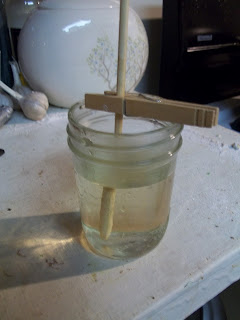my recipe came from candy.about.com
materials:
2 cups of water
4 cups of sugar (a 2 pound bag works in terms of quantity)
1 medium sauce pan
a rubber or silicon spatula or spoon
1 glass mason jar, 1 1/2 cup qty.
one clothes pin, pref. the spring loaded variety
one bamboo skewer or disposable chop stick (such as you get with an order from an Asian restaurant)
optional
1 qt. sized glass mason jar, plus lid, one piece or a ring and top.
vessel for holding 4 cups of sugar
one separate measuring utensil for the water
one separate measuring utensil for the sugar
Also helpful if not already in a kitchen -
a dish pan of hot, soapy water standing by to immediately soak used measuring cups and sauce pan in. Trust me.
in case you don't have a skewer and a clothes pin...*
a clean length of cotton string
a pencil
a clean paper clip
I opted not to use food coloring or flavoring. Mostly because I didn't want to make a special trip to the store this morning.
2 cups (500 mL) of water. I used cold water straight from the tap.
I set the burner (it's a gas stove) on Medium heat.
My very large mug and a small, 2# bag of sugar.
I measured it out ahead of time into the mug to make sure I had the right amount.
 |
| measuring out the sugar |
The water +1 cup of sugar
water (obviously boiling now) plus 2 cups of sugar
it is important that the water is hot enough for the sugar to dissolve, but not boiling so much that the sugar is forming bubbles and threatening to overflow the pan. Keep the heat at medium or slightly lower, and KEEP STIRRING! This might be a good time to dampen your skewer or string, since there is already sugar in the water. A skewer is very easy to swirl around in the syrup, and can be set aside in it's small mason jar until the syrup is finished.
adding the rest of the sugar.
Now we are at 2 cups of water + 4 cups of dissolved sugar. It feels fairly syrupy at
this point when stirring. again, make sure the sugar is dissolved - none should be visible.
Before pouring the syrup into the experiment container (ie: small mason jar), it is a good idea to have something underneath it to catch any spills. The jumbo mug is the perfect vessel since it already had sugar in it. The skewer and clothes pin do not need to be in place, in fact, it's more helpful if they aren't.
the treated skewer submerged in the sugar syrup with a little space between
the end of the skewer and the bottom of the jar
The materials sacrificed on the alter of science being immediately cleaned with dish soap and hot water. Crusty sugar syrup is a nasty mess to clean up when dry.
*I hate putting this at the end, but I wanted to get on with the pictures.
The string, paper clip and pencil are in place of the skewer and clothes pin, either are for the sugar crystals to form on. For the string method, tie one end of the string to the paper clip, and the other end to the pencil. Dampen the string in a little water and lightly coat it with granulated sugar (this will help the crystals latch on) When the syrup solution is ready, submerge the paper and string into the liquid, and roll the string up until there is about an inch of space between the bottom of the jar and the paperclip when the pencil rests on the top of the jar.
Whether or not a skewer or a string and paperclip is used, it is important to set the jar aside somewhere out of the way. If the liquid is agitated, the crystals won't form.









No comments:
Post a Comment